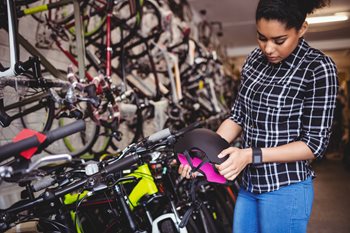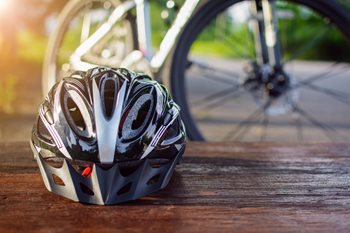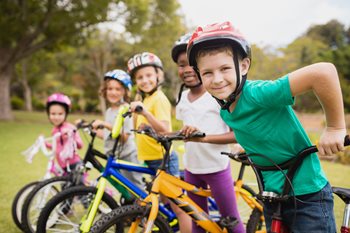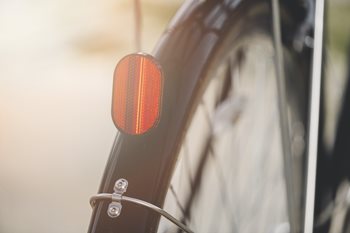Use your head, wear a helmet. It is the single most effective safety device available to reduce head injury and death from bicycle crashes.
 Find the Right Helmet Fit
Find the Right Helmet Fit
Make sure you have the right size helmet and wear it every time when riding, skating or scooting. Your helmet should meet the U.S. Consumer Product Safety Commission's (CPSC) standards. If you have children, let them pick out their own; they'll be more likely to wear them for every ride.
Make sure the helmet fits. A helmet should sit on top of the head in a level position, and should not rock forward, backward or side to side. The helmet straps must always be buckled, but not too tightly. Safe Kids recommends children take the Helmet Fit Test:
- EYES: Position the helmet on your head. Look up and you should see the bottom rim of the helmet. The rim should be one to two finger-widths above the eyebrows.
- EARS: Make sure the straps of the helmet form a "V" under your ears when buckled. The strap should be snug but comfortable.
- MOUTH: Open your mouth as wide as you can. Do you feel the helmet hug your head? If not, tighten those straps and make sure the buckle is flat against your skin.
 Use Appropriate Helmets for Different Activities
Use Appropriate Helmets for Different Activities
- Both adults and children should ALWAYS wear a properly-fitted helmet when riding a bicycle or scooter, roller skating or in-line skating.
- Children under the age of 16 are required by Florida law to wear a helmet.
- When skateboarding and long boarding, make sure to wear a CPSC certified skateboarding helmet.
Proper Equipment and Maintenance Are Important
- When purchasing a bike, select one that is the right size for you now, not one you will grow into.
- When sitting on the seat of the bicycle, your feet should be able to touch the ground.
- Before you ride, make sure reflectors are secure, brakes work properly, gears shift smoothly, and tires are tightly secured and properly inflated.
- Long or loose clothing can get caught in bike chains or wheel spokes. Dress appropriately to ensure a safe ride.
 Model and Teach Good Behavior
Model and Teach Good Behavior
- You'd be surprised how much kids learn from watching you, so it's important for parents to model proper behavior. Wear a helmet, even if you didn't when you were a kid.
- Teach your kids to make eye contact with drivers. Bikers should make sure drivers are paying attention and are going to stop before they cross the street.
- Tell your kids to ride on the right side of the road, with traffic, not against it. Stay as far to the right as possible. Use appropriate hand signals and respect traffic signals, stopping at all stop signs and stoplights. Be predictable when riding.
- Stop and look left, right and left again before entering a street or crossing an intersection. Look back and yield to traffic coming from behind before turning left.
Be Bright, Use Lights

- When riding at dusk, dawn or in the evening, be bright and use lights – and make sure your bike has reflectors as well. It's also smart to wear clothes and accessories that have retro-reflective materials to improve biker visibility to motorists.
- Most states require a front light but allow the use of a rear reflector. Headlights aren't so much for bicyclists to see where they are going but for others to see them. Riding without a headlight means drivers won't see you, and surprising motorists is never a good idea.
For additional tips and resources visit Safe Kids Worldwide (https://www.safekids.org/bike).